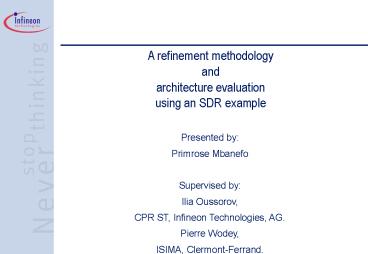Mthodologie de Conception de Systme pour Architectures Parallles PowerPoint PPT Presentation
1 / 25
Title: Mthodologie de Conception de Systme pour Architectures Parallles
1
A refinement methodology andarchitecture
evaluation using an SDR example
Presented by Primrose Mbanefo Supervised
by Ilia Oussorov, CPR ST, Infineon Technologies,
AG. Pierre Wodey, ISIMA, Clermont-Ferrand.
2
PLAN
- Introduction
- The methodologie
- The refinement proposition
- Validating the refinement
- UMTS
- SIMD
- The refinement process
- The refinement
- Functional level
- DPCE
- Transactionnal level
- Conclusion
3
Introduction
- UMTS
- Parallel architecture
- SystemC methodology
- SystemC
- A system level design language
4
System Level Design
- Objective
- Unification of the developpement of hardware and
software
A system
5
The proposed refinement
- Hardware and software introduction
System conception
6
SDR
- SDR Software Defined Radio
- Software controlled characteristics
- Modulation techniques, security functions,
frequency ... - Uses simpler hardware platforms
7
Technical generations
- 1st generation
- Early 80s
- First analog cellular systems
- 2nd generation
- Early 90s
- First digital cellular system
- 2.5 generation
- Late 90s
- Enhanced 2g systems data rates are up to 144kbs
- SMS, Pictures
- 3rd generation
- concerns TODAY!
- data rates should go up to 2Mbs
- Multimedia, Internet, Broadband
8
UMTS Network
- UMTS Universal Mobile Telecommunication System
- European 3G system
UMTS Network
9
Cells
Cells
- Intercell-Interferences
- Echos
10
CDMA
- Synchronising to a base station
- CDMA technique is used for this
- CDMA Code Division Multiple Access
- as opposed to
- FDMA - Frequency DMA
- TDMA - Time DMA
F/T/C-DMA
11
UMTS data
- Data format
- Frames
- Slots
- Chips
- complex numbers
A frame of data
12
Codes for synchronisation to the base station
- Primary synchronisation code
- The same for all base stations
- completely orthogonal
- Aids in slot detection
13
group 3
14
Codes for synchronisation to the base station
- The third and last code for synchronisation
- The primary scrambling code
- There are 512 primary scrambling codes divided
into 64 groups of 8 codes - Each base station uses one of the codes in the
group used in the secondary synchronisation code - Example
Base station is identified with primary
scrambling code 5 of group 3
15
Synchronisation channels
- The synchronisation codes are transported by
three channels - The Primary Synchronisation CHannel (P-SCH)
- The Secondary Synchronisation CHannel (S-SCH)
- The Common PIlot CHannel (CPICH)
Cell search channels and codes
16
Initial cell search
- Initial cell search Search for the strongest
base station signal effectuated by the users
equipment (mobile phone, pda, laptop) on start-up - Made up of the three synchronisations
- Primary synchronisation
- The UE knows where the start of slot of the
strongest BS is found - Secondary synchronisation
- The UE knows where the start of frame of this BS
is found - It also knows which code group it belongs to
- Primary scrambling code search
- The UE knows exactly which data is coming from
the BS
17
Initial cell search
- Cell search is known to be time consuming because
of the numerous computations to be done - Detect its critical points
- Evaluate a target architecture based on SIMD cores
18
SIMD
Shared Memory
Parameters
- Local memory size
- Memory bus widths
- Number of PEs
- Number of registers
SIMD core architecture
19
The refinement process
- Usual
Classical refinement process
20
The refinement process
- Proposed
The refinement to be validated
21
Functional level
- Aims
- Understand the application
- Give a preliminary evaluation of the architecture
- First obstacle
- The communication channel
- 3 levels of data representation
- Make the 3 levels co-exist
22
Data parallelism extraction
- SystemC has no way of expressing data parallelism
- DPCE Data Parallel C extension
- Translating from SystemC to DPCE
- rather straight forward
- SystemC modules become DPCE files
- Procedures and functions will be in their
respective files - Data structures become DPCE shapes
- e.g frame class becomes a shape
- Programmer should bear in mind that this is data
parallel code - Where possible use the parallel operators on
parallel objects
23
Entire model representation
- Model used by the two levels
24
SIMD
Shared Memory
Parameters
- Local memory size
- Memory bus widths
- Number of PEs
- Number of registers
SIMD core architecture
25
Conclusion
- Two versions of the Untimed Functional Level
exist - It takes 4 weeks to write it the first time to
get a good understanding - Two versions of the Timed Functional Level exist
- It takes about two weeks to refine it once a
refinement direction has been chosen - Working on the TLM

